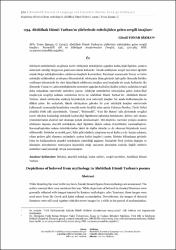| dc.contributor.author | Şişman, Gönül Yonar | |
| dc.date.accessioned | 2023-07-27T10:46:11Z | |
| dc.date.available | 2023-07-27T10:46:11Z | |
| dc.date.issued | 2023 | en_US |
| dc.identifier.citation | ŞİŞMAN, Gönül Yorar. "Abdülhak Hâmit Tarhan’ın Şiirlerinde Mitolojiden Gelen Sevgili İmajları". RumeliDE Dil ve Edebiyat Araştırmaları Dergisi, 32 (2023): 570-585. | en_US |
| dc.identifier.uri | https://dergipark.org.tr/tr/pub/rumelide/issue/75934/1252807 | |
| dc.identifier.uri | https://hdl.handle.net/11352/4614 | |
| dc.description.abstract | Edebiyat metinlerinde sevgilinin tasvir edilişinde mitolojiden çağrılan kadın/dişil figürler, yazarın aktarmak istediği duygunun göstereni olarak kullanılır. Klasik edebiyatın sevgili tasvirleri ağırlıklı olarak Doğu mitolojilerinden esinlenen imajlarla kurulurken, Tanzimat sonrasında Yunan ve Latin mitolojik müktesebatı yenileşme dönemindeki edebiyatta daha görünür hale gelir. Bununla birlikte yenileşme döneminde bir süre daha klasik edebiyatın imajları yeni imajlarla bir arada kullanılır. Bu dönemde Yunan ve Latin mitolojisinden metinlere çağrılan kadınlar/dişiller yoluyla anlatılan sevgili daha müşahhas tasvirlerle metinlere yansır. Edebiyat metinlerine mitolojiden gelen kadın/dişil imajlarıyla sevgiliyi anlatan isimlerden birisi de Abdülhak Hâmit Tarhan’dır. Abdülhak Hâmit Tarhan, klasik edebiyatın söyleyiş biçimleriyle yeni mitolojik imajları bir arada kullanmasıyla da dikkat çeker. Bu makalede, klasik edebiyattan gelenler ile yeni mitolojik imajları eserlerinde kullanmak konusunda kendinden sonraki nesle öncülük eden şairin Yabancı Dostlar, Tarık Yahut Endülüs Fethi adlı piyeslerinde, “Garam”, “Mütesadif”, “Yine Bir Hatıra” adlı şiirlerinde sevgiliyi tasvir ederken kullandığı mitolojik kadın/dişil figürlerine yakından bakılmıştır. Şiirler, mit okuma yöntemlerinden eleştirel mit okuması içinde alımlanmıştır. Mit eleştirisi, metinler yoluyla modern edebiyata taşınan ataerkil mitolojinin dişil figürlere ilişkin anlam örüntülerini sorunsallaştırır. Sorunsallaştırılan anlam örüntülerinden birisi de dişilin olumlu ya da olumsuz biçimlerde tasvir edilmesidir. Metinler ya melek, peri, ilâhe gibi sıfatlarla ulaşılmaz soyut kadın ya da baştan çıkaran, yıkım getiren gibi olumsuz anlamlarla şeytan kadın imgeleri yaratır. Metnin bilinçdışını görünür kılan bu kullanımlarla ataerkil mitolojinin sürekliliği sağlanır. Makalede Türk şiirinin değişim ve dönüşüm süreçlerinde mitolojinin kaynaklık ettiği malzeme üzerinden kadınla ilişkili mitlerin metinlere nasıl yansıdığı ortaya konulmuştur. | en_US |
| dc.description.abstract | While depicting the lover in literary texts, female/female figures from mythology are summoned. The author conveys their own emotions this way. While depictions of beloved in classical literature were generally reflected with images inspired by Eastern mythologies, after Tanzimat, these images were used more from the Greek and Latin cultural accumulation. Nevertheless, the images of classical literature were still used together with the newer images for a while in the period of modernization.In this period, the “Beloved” which is told through the women/females summoned to the texts from Greek and Latin mythology, is reflected to texts with more concrete depictions. Abdülhak Hamit Tarhan is one of the names who had described the beloved in literary texts with the female/feminine images from mythology. Tarhan is also remarkable with his usage of new mythological images and the utterance of forms in classical literature together. This research, focused on the mythological female/female figures while describing the beloved in poems and plays named Yabancı Dostlar, Tarik Yahut Endülüs and “Garam”, “Mütesadif”, “Yine Bir Hatıra”, written by Tarhan who led the next generation in terms of using new mythologival images with the ones came from classical literature in their works. The poems were recepted within the myt reading method, which is one of the myth reading approaches. Critcal myth reading problematizes the semantic patterns of patriarchal mythology related to feminine figures, that were carried to modern literatüre through texts. One of the problematized semantic patterns is the description of feminine forms as positive (angel) or negative (devil/demon). The texts create images of either a heavenly and intangible woman labeled as angel, fairy, goddess or seductive, destructive with negative sense. The sustainability of the patriarchal mythology is ensured with these expressions that make the undersense visible. In this article, it is revealed how the myths related to women are reflected to the texts through the material that mythology became the source of in the change and transformation processses of Turkish poetry. | en_US |
| dc.language.iso | tur | en_US |
| dc.publisher | RumeliYA Yayıncılık | en_US |
| dc.relation.isversionof | 10.29000/rumelide.1252807 | en_US |
| dc.rights | info:eu-repo/semantics/openAccess | en_US |
| dc.subject | Mitoloji | en_US |
| dc.subject | Ataerkil Mitoloji | en_US |
| dc.subject | Kadın Mitleri | en_US |
| dc.subject | Sevgili Tasvirleri | en_US |
| dc.subject | Abdülhak Hâmit Tarhan | en_US |
| dc.subject | Mythology | en_US |
| dc.subject | Patriarchal Mythology | en_US |
| dc.subject | Myths of Women | en_US |
| dc.subject | Images of Beloved | en_US |
| dc.title | Abdülhak Hâmit Tarhan’ın Şiirlerinde Mitolojiden Gelen Sevgili İmajları | en_US |
| dc.title.alternative | Depictions of Beloved from Mythology in Abdülhak Hâmit Tarhan’s Poems | en_US |
| dc.type | article | en_US |
| dc.relation.journal | RumeliDE Dil ve Edebiyat Araştırmaları Dergisi | en_US |
| dc.contributor.department | FSM Vakıf Üniversitesi, Edebiyat Fakültesi, Türk Dili ve Edebiyatı Bölümü | en_US |
| dc.contributor.authorID | https://orcid.org/0000-0003-2091-7089 | en_US |
| dc.identifier.issue | 32 | en_US |
| dc.identifier.startpage | 570 | en_US |
| dc.identifier.endpage | 585 | en_US |
| dc.relation.publicationcategory | Makale - Uluslararası Hakemli Dergi - Kurum Öğretim Elemanı | en_US |
| dc.contributor.institutionauthor | Şişman, Gönül Yonar | |



















